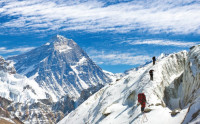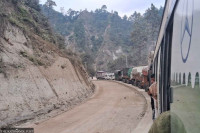Opinion
The new opium of Nepalis
It’s much easier to bind the minds of the middle class with the imagery of a giant ship
Sabin Ninglekhu
Let’s begin with a well-worn cliché: Unless politics, not the everyday ‘ordinary’ kind, but the kind that can shape the everyday life of the ordinary people, is infused with egalitarianism, ‘stability’ and ‘prosperity’ will always have a ‘class’ character. After nearly two decades of relative latency since the 1990s, infrastructure has re-emerged as a governing logic on the national scale that mediates discussions about bikas. In other words, the present time contains more currency than ever before for politicians of all hues that are commoditising politics as neatly packaged aesthetics high on elite steroids. Singapore, Smart City, Satellite City, Sky Rail, Mono Rail and Metro Rail could all coexist under the united colours of capitalism. This is the hegemonic time of high-tech railways and world class airports, after all.
The kind of aesthetics that these imageries conjure up has the power to reduce politics to the realms of spectacle, fantasy and entertainment. In the process, aesthetics also conceals the stuff of everyday life that matter: cheaper housing rent and affordable health and education services; accessible markets for farmers and accountable municipal and ward offices for the ordinary. But quite tellingly, this recourse to the politics of aesthetics also reveals laziness among those politicians that lack the imagination and hard work to rebuild politics.
Misplaced priorities
Ram Gopal Maharjan is a local in a Newar town destroyed by the earthquake which was subsequently re-declared as a Heritage Settlement amid much fanfare. To rebuild his house, Ram Gopal has to stick to two sets of governmental mandates:
One, structural safety measures prescribed in the building codes, and two, architectural requirements specified in the rebuilding bylaw which, among other things, mention that the façade should display Newar architecture.
These conditions mean that Ram Gopal needs to assemble a sizable amount of money. A five-foot deep foundation with re-bars laid horizontally and vertically would cost twice as much as they used to before the earthquake, because of new structural requirements. Ram Gopal has now stalled construction for two reasons: One, the foundation already cost much more than he had budgeted for, and two, the wooden doors and windows that the heritage bylaw mandates cost thrice as much as aluminium frames. The current dilemma is whether to sell his remaining farmland to complete construction, or to wait for the government-endorsed subsidised housing loan that may never arrive.
Taking the former option would mean being detached from the land that has historically sustained life for nearly half the year, every year, through grains produced. More importantly, it would mean being bereft of any fall-back option should there be another disaster of the same kind. Taking the latter option, of loan, is filled with uncertainties because being eligible to even apply for the government’s subsidised housing loan would mean, first and foremost, becoming worthy of the credit, to be evidenced through a consistent and documented flow of income.
Ram Gopal, the artisan, relies on occasional orders dispatched from Patan to produce woodcraft. The handicraft workshop is not registered because there was never the need for one. And then, there is this small issue of obtaining the building permit first, which the municipality will only provide after Ram Gopal has had his land title issued from the Land Office. The path to obtaining the title is littered with bureaucratic misgivings that Ram Gopal is unaware of. The subsidised loan with an interest of 2 percent is, therefore, a paper dream.
One way to look at Ram Gopal’s predicament is through the lens of governance. Wishful thinking would dictate that the Ministry of Urban Development could potentially coordinate with the National Reconstruction Authority (NRA) and the Department of Archaeology, alongside Nepal Rastra Bank, including the Nepal Bankers’ Association, to resolve some of Ram Gopal’s dilemmas. But such a move would require a radically different kind of Nepali state. Further, if a top-level official of the NRA is to be believed, it is the World Bank’s distrust of Nepal’s local and municipal authorities’ capabilities that is preventing the NRA from decentralising the duties linked to disaster governance.
If that is the case, any move to decentralise governance in substantive terms to address Ram Gopal’s situation could involve jeopardising the government’s relationship with both the donor and its distant cousins who might be surreptitiously benefitting from the existing fix. And quite frankly, attempting to get rid of bureaucratic inertia is an invisible work devoid of individual gain. Instead, it is much easier, and definitely more heroic, to bind the minds of the middle class with the imagery of a giant ship; the waving sun and moon emblazoned on the red and blue of the Nepali flag announcing its eventual arrival in the Bay of Bengal. As such, the self-infatuation and delusions of grandeur that oil Oli’s infrastructure turn is the new opium of the Nepali people.
Ninglekhu is conducting a long-term ethnographic research on the everday politics of post-earthquake rebuilding in Kathmandu Valley




 16.63°C Kathmandu
16.63°C Kathmandu












